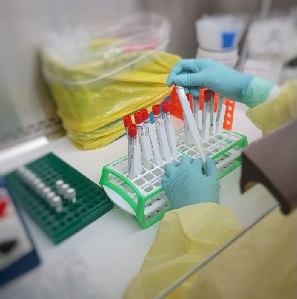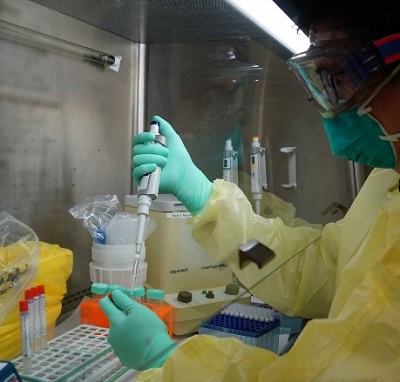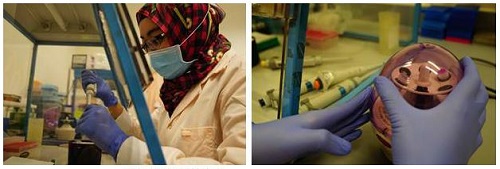HIV, Hepatitis B and C, Influenza A/H1N1/2009, MERS Coronavirus, Zika virus and now SARS-CoV-2. Our team in the Molecular Laboratory routinely analyses samples from patients to diagnose such infectious diseases.
So when COVID-19 happened, the team’s workload tripled almost overnight. And as Singapore crossed the 10,000 mark in number of cases, our laboratory has been running tests continuously throughout the day and overnight since 21 April 2020.

A single batch consists of an average of 90 samples. Each batch takes about 4-6 hours to process and analyse.
Medical Laboratory Technologists Eileen Goh and T Shalini revealed that they managed with a combination of longer work days and reinforcement from the other laboratories in SGH Division of Pathology. The Molecular Laboratory itself has 20 technologists and scientists.
Another initial area of pressure was to get stock of consumables and reagents that are needed for the COVID-19 tests. “Because of the sudden spike in demand, we had to negotiate with vendors to get the additional stocks quickly. Supply is limited as labs all over the world are looking to buy the same items. That was more stressful than doing the tests,” said Shalini. The Ministry of Health subsequently stepped in to procure supplies through its centralised purchasing arm, ALPS Pte Ltd.
Pulling in the hours
“On a normal day before the COVID-19 outbreak, we were doing about 140 specimens a day. Now, after three months, we are processing up to five times more samples,” said Shalini. “Work is pouring in like torrential rain!”
Since mid-April 2020, the laboratory has also been receiving samples from mobile medical clinics and mobile swab teams operating in the migrant worker dormitories, which have contributed to this large increase in workload.
“We used to work from 8am to 5.15pm, with a half-day on Saturday and a rest day on Sunday. But with COVID-19, all of us work six days a week with staggered hours from 7am to 11pm, including Sunday and public holiday. We have each put in many hours of overtime,” said Eileen. “We have dedicated shifts who work solely on COVID-19, while other staff handle both the routine work of testing for the other viruses, as well as COVID-19.”
The SGH Molecular Laboratory serves hospitals from across Singapore for the routine tests. “But for COVID-19, we focus on running tests for SingHealth institutions and Health Sciences Authority,” said Eileen who has been with SGH for the past 6 years.

A staff scans the CPOE barcode label to receive a sample for COVID-19 testing.
Calling in the Reserve Force
To help her staff cope with the increased load, Head of the Molecular Pathology Department A/Prof Lynette Oon reached out to the other laboratories in the Pathology Division for reinforcement through its Chairman Prof Tan Puay Hoon. The result is a ‘Reserve Force’ comprising colleagues who volunteered from the laboratories of Diagnostic Bacteriology, Virology, Cytology, Immunology & Serology, Cytogenetics and Translational Pathology Centre.
The Diagnostic Bacteriology Laboratory under the Department of Microbiology, in particular, has stepped in to help run the overnight tests, so that tests are now run continuously throughout the day and overnight from 21 April 2020.
In fact, the entire Division of Pathology has stepped up during this period. Administrators from Client and Specimen Management Section of Clinical Pathology are helping out with the large number of samples from migrant workers in the dormitories. They assist to enter patient details and manual ordering of tests done by mobile teams at the dormitories into the Laboratory Information System. Other staff in the division are playing a huge role in many other operations matters. In addition, the Division of Research has started providing researchers to help the laboratory team with the COVID testing as well.
“It’s good exposure for all of us because we usually don’t meet colleagues from the other labs. In our routine work, we do send some of our samples onwards to them. Now they get to see the work we do,” said Eileen.
"They also learn new skills as what they do is totally different from what we do in our lab. For example, for bacteriology, culturing skills are very important but for us, it’s pipetting skills,” added Shalini.

Good pipetting techniques are essential for Molecular Laboratory technologists
Routine lockdown for safety
Heightened precautions are necessary as COVID-19 is highly contagious, and being a novel i.e. new virus, there is still insufficient knowledge.
“The moment we are preparing to run tests on COVID-19 samples, everyone in the lab has to put on Personal Protective Equipment (PPE) including the N95 mask, even if you are not doing the test. When the processing starts, the lab is on ‘lockdown’, with no one allowed to enter or leave until the procedure is completed. Our lab is equipped with negative air pressure between the lab and the outside office. This is a strict lab biosafety-standard procedure designed to prevent any possible contamination to the outside. When the test is done, we signal to the colleagues in the outside office, so that we can open the air-lock of both doors at the same time. Our lab is very, very safe,” said Eileen, reassuringly.
It’s a procedure the team is very familiar with as this ‘lockdown’ is also done for other routine tests like MERS coronavirus and the avian influenza virus PCR test.
 Afni Supandi, a medical laboratory technologist, prepares the reagents for the COVID-19 PCR test
Afni Supandi, a medical laboratory technologist, prepares the reagents for the COVID-19 PCR test
Shalini, who joined the Molecular Laboratory two years ago, was initially a little fearful of dealing with the COVID-19 samples. ‘At the start, when not much was known of the virus, we weren’t sure if the precautions were enough. But our seniors and bosses made it a point to constantly update us. We had many briefings daily and this helped allay my fears.’
Family matters
For Eileen, her work with the COVID-19 virus has given her husband anxiety. “My husband is worried for me, but he trusts the way SGH works and believes that SGH will keep us safe. So that’s good. Our labs put in a lot of precautionary measures. We are actually doing more than necessary.”
Shalini, who lives with her parents, has a different experience. “My family doesn’t really understand the nature of my job. So they were like, ‘Oh you need to stay back late for work? Okay.’ I didn’t explain because it’s too difficult. And because they don’t understand my job, they are not worried.”
The team now feels better after three months. There is a fixed workflow, which is stable and systematic. ‘We’re more confident and we know what to expect now, the new norm has become routine,’ shared Eileen and Shalini.
We love mail! Drop us a note at [email protected] to tell us what you like or didn’t like about this story, and what you would like to see more of in LighterNotes.
